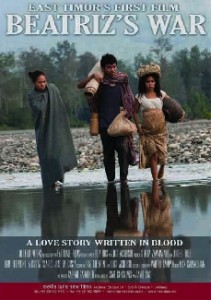July 14, 2014: This review has been updated from what was originally published on July 10.
Timor Leste is one of Australia’s closest international neighbours. But despite its proximity, this young nation is an enigma to most Australians. A few of us may have seen Balibo late one night on ABC, or may remember reading news stories about the nation’s independence in 1999, but our collective knowledge of this state is generally limited.
Luigi Acquisto and Bety Reis‘ A Guerra da Beatriz (Beatriz’s War) won’t necessarily give Australians the history textbook knowledge they might need, but it should spark an interest in those who see it. It follows the story of Beatriz and Tomas (Irim Tolentino and Jose da Costa), a young couple who grow up together in the midst of civil war. As they flee from one place to another, they are subject to intense brutality at the hands of the Indonesian military. Not long after the birth of his child, Tomas is captured by the Indonesians, but Beatriz clings onto the hope that he remains alive. What results is in an ending you won’t be able to predict.
Without giving away any spoilers, Beatriz’s War is a film for realists. Don’t let the Beatriz-Tomas love story fool you – this is not a romantic film for young couples. Likewise, audiences won’t be rushing to purchase flights to Timor Leste after this screening; the film paints a bleak picture of the country’s past. Indeed, the greatest reality checks are evident in the scenes post independence. While optimistic audiences may expect this to be a breakthrough in the narrative, it isn’t.
Aesthetically speaking, Beatriz’s War is not a pretty film. As can be expected from a novice film industry and a low-budget feature, some of the acting and lighting is below international standard and the production values are low. But these characteristics only reinforce one of the film’s take-home messages, that Timor Leste is making progress, but still has much room to grow.
That’s not to say the film is without any positives. While Beatriz’s War is an important reminder for aid-giving countries to not forget about Timor Leste, it also introduces its audience to a number of strong female leads. Beatriz’s War empowers women far more than most Hollywood films, portraying even the most socially and politically powerless women as people of agency and strong wills. In doing so, it demonstrates how vulnerable people can be drivers of their own change and can pull their communities out of dire straits. And that may well be the first piece of the Timor Leste puzzle Australian audiences need.
Beatriz’s War is in selected Australian cinemas from 10 June through FairTrade Films







Dear Kevin
We don’t normally write to reviewers but in this case we both feel compelled. You, as a critic, have the right to publish your critique on films. However, please don’t make sweeping statements about our film, and about East Timor, which are incorrect and ignorant of historical realities. Firstly, East Timor is not Australia’s closest neighbour.
Secondly, the Ministry of Tourism and Culture in Timor financially supported the production of the film, as well as its distribution locally and internationally. The history of Timor’s struggle is not an embarrassment to Timorese. They are proud of their courageous struggle and of this film. The film was also supported financially by the office of Prime Minister Xanana Gusmao and the President’s Office.
Thirdly, the production values of the film, despite its modest budget, won it two major ACS cinematography awards in Victoria/Tasmania-Best Feature and best overall Cinematography in any Category. It then competed nationally in the ACS awards against Gatsby.
Fourthly, the acting – Irim Tolentino was nominated for the Best Actress prize at the International Film Festival of India. She didn’t win but the film did! It took out the top prize in the country with the world’s biggest film industry, and greatest love for cinema. This from the country with the world’s smallest and newest industry.
Finally, the collective knowledge of Timor is unusually great in Australia-we fought there in WW2, supported the struggle for 24 years, sent troops in 1999 and 2006, etc etc, etc….There is probably more awareness of Timor than any other country in our region. Evidence is that the film has sold out every night so far at Cinema Nova.
I don’t see the relevance of you borrowing current statistics about Timorese poverty (again inaccurate) in relation to our film. We do not state these figures in the film, and giving a context to the poverty in one of the world’s poorest nation, that is 460 years of Portuguese colonisation followed by a brutal 24 year occupation – doesn’t seem something one should hide.
Thanks for your positive closing comments but please do your research in future before making statements about a country, it’s history, or film in general. It is this sort of misinformation from Australian journalists and government officials that masked, and covered up, the atrocities that were happening in Timor during the war with Indonesian, a war that resulted in the death of over 1/4 of the population, the highest genocide per-capita in history.
Contributed by Lurdes Pires (producer) & Luigi Acquisto (co-director)
Dear Lurdes and Luigi
Thank you for making the time to read and respond to my review, and congratulations on your work on Beatriz’s War.
Please understand that I did not intend to portray the film and your nation in a negative light, and by no means wished to suggest that Timorese people were not proud of their country and their history. The point I was trying to make was that the film presents many sad and unfortunate aspects of Timorese history (which is understandable). And while the film does highlight some very positive elements about the country (through inspiring characters like Beatriz), it also doesn’t present the country as a particularly appealing tourist destination. I know that the film is set in the past and flaunting the country wasn’t the point of the film, but I personally felt that was a useful example to make in assessing the film’s tone and aesthetics.
I originally included the statistics about poverty as a way of raising awareness about the country and its present situation. I stand by my point that not many Australians – or at least not many Australians my age – know much about Timor Leste. As such, I felt that including this statistic would help readers understand that while progress has been made, there is still significant room for growth.
On a personal note, I again wish to congratulate you on the success of this film to date. While my review did contain some criticism, I was overall impressed with the film and the team behind it and look forward to seeing future Timorese films and the growth of the Timorese film industry.
Regards
Kevin Hawkins